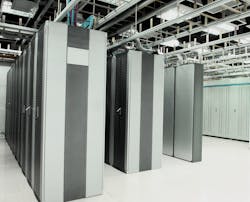The data center industry has garnered increased attention as we begin to understand how our digital world is supported by this unseen physical infrastructure. With this attention, also come questions about the sustainability of the data center industry.
Data centers use water to cool their servers, which can impact local water supplies. Water is increasingly being recognized as a risk to data center operation as a decreasing supply can potentially disrupt our continuous access to data. As such, industry leaders are adopting ambitious environmental, social and governance (ESG) targets with water at the forefront of the conversation. To date, most industries have focused their water stewardship strategies on reducing their water withdrawals. Water stewardship strategies are now going beyond water use minimization to incorporate actions aimed at replenishing water consumed and improving overall watershed health.
Sustainability drivers and frameworks
According to the May 2021 Sustainability Survey, the top three reasons why data center operators pursue sustainability are: economic, corporate policy and customer pressure (DatacenterDynamics 2021). External pressure is anticipated to become increasingly more important as sustainability commitments become expected by investors and a necessity to attract customers. Political pressure and an aggressive push for risk transparency from the investment community are also driving the increase in ESG commitments.
The data center industry is on the leading edge of innovation and in an enviable position to drive regulatory change as opposed to waiting for regulations to be imposed. Some of Europe’s largest data center operators have taken a proactive step by committing to a plan for self-regulation. The “Climate Neutral Data Centre Pact” commits the industry to “climate-neutral” by 2030 (Sverdlik 2021). This means purchasing 100% carbon-free energy and prioritizing water conservation.
A key economic sustainability driver is investment opportunities. Both low interest long-term loans and private equity funding now commonly require ESG commitments as a prerequisite for investment. The reporting and external verification requirements, under the loan agreement, are intended to protect the borrower from green washing and improve the credibility of a borrower.
Existing ESG reporting frameworks require improvement to adapt to the quickly evolving market. Several key changes are emerging, starting with the need for mandatory ESG reporting and expanding beyond water footprint-reporting (Sarni 2021).
Sustainable data centers: Power and water
By some estimates, the data center industry is responsible for 1% of the global electricity consumption (Jones 2018). On average, a data center uses 1.8 L of freshwater per kWh of IT power consumed (Shehabi et al. 2016, 28). In comparison, it takes 57 L of water to produce 1 kWh of electricity in the U.S. (Dieter et al. 2018, 42). Traditionally, sustainability goals have focused on energy over water, but that trend is shifting.
Cloud leaders have announced bold commitments to reduce carbon footprint, use renewable energy and reduce water usage. Investing in new renewable energy sources has a positive net effect towards decarbonization. Most of the data center operators already run on 100% renewable energy (e.g., solar, wind, geothermal). Typically, data centers offset their non-renewable power use by purchasing renewable energy certificates (REC) and power purchase agreements (PPA). The REC allows the purchaser to take “credit” for the RECs as renewable power “use” and PPAs can be purchased from a qualified renewable resource without requiring its direct use. Nowadays, more data centers are operating on the same grid to which the contracted facility is delivering power. Regardless of the arrangement, the data center industry has contributed to significant advancements of the renewable energy industry. Similarly, the industry is expected to contribute to advancements in the development of creative solutions to offset their water use.
Achieving the most sustainable solution for data center cooling requires balancing power and water usage. Cooling technologies that use no water come at the expense of power usage and hence are not the most sustainable solution. As technology evolves, the most sustainable solution is one that is based on overall energy efficiency, water stewardship and total cost of ownership.
Data center water – inside/outside the fenceline
Water stewardship actions can be taken inside or outside the data center fenceline. Projects inside the fenceline target operational efficiency (i.e., increasing cycles of concentration [CoC] so that water can be used more efficiently). Projects outside the fenceline typically target water replenishment (i.e., returning water to the ecosystem from which it was sourced).
When possible, data centers use cooling technologies that minimize water use. In cool and moderate climate regions, adiabatic cooling can be used for cooling the data servers, resulting in reduced energy and water consumption. During cooler months, outside air is directly supplied to the data center without using any water and during warmer months, the warm air is drawn through water-moistened pads. As the water in the pads evaporates, the air is chilled and pushed into the server halls. In warmer climates, cooling towers and chillers, which use substantially more water than adiabatic cooling systems, are used to provide the higher degree of heat dissipation required.
Other strategies to reduce potable water consumption include the use of non-potable water sources. While some large data center operators have been successful in using non-potable water sources for cooling, not enough attention has been given to alternative water sources in site selection. Notably, many data center operators use recycled water for cooling in northern Virginia. In locations where recycled water is readily available, its use should be encouraged and prioritized to conserve valuable potable water resources.
Data center operators are making commitments to replenish water in the watersheds impacted by their operations, with a primary focus on water scarce areas. The projects can range widely in scope from ecosystem protection and restoration to water rights reallocation. Projects are typically identified by a non-profit organization, funded by the data center operator, and verified by a qualified third party.
Water replenishment: Challenges and opportunities
The food and beverage industry’s water replenishment programs have laid the foundation for project execution leveraged by many industries. The traditional approach was designed to help companies meet objectives through a relatively simple accounting methodology. However, a driver for increased transparency has emerged as a result of increased scrutiny. A more comprehensive approach is taking shape — one that allows corporations to better understand and manage their water risks, build more resilient operations, and strengthen their reputation and credibility.
A water replenishment program starts with setting program goals (e.g., 100% replenishment of all water consumed by 2030). This requires strategic consideration of water use and water assets, careful analysis of risks and prioritization of projects for investment. Corporate water replenishment goals and metrics need to be established. Measurable metrics are leveraged to drive the identification, selection and prioritization of projects, and then used to track progress, improve budget planning and ultimately meet program goals with increased certainty.
Common implementation challenges include:
- Project identification, prioritization and selection. A large database of projects is useful to identify and select projects based on pre-established metrics. Key metrics include project cost, schedule, replenishment credit and duration. Priority criteria may include cost per volume replenished, schedule and proximity to site. Partner selection is also important (i.e., non-profit, municipality, both) — a strong partnership based on trust will lead to successful project implementation.
- Budget development. An investment plan, to meet a specific replenishment commitment, will provide the opportunity to level out the spending over time and define funding requirements. Based on the opportunities and timing, the plan may require heavy investments early in the funding cycle. Evaluating the enduring value of a project justifies near-term investment with long-term returns while identifying funding gaps.
- Risk identification. It is not atypical to underestimate risk (e.g., climate change, financial, local utility’s ability to deliver on schedule). Once risks are identified and quantified, a plan can be developed to address uncertainties. Understanding the risks, benefits, timelines and return on investments will help develop a strategic approach to prioritizing projects and achieving water replenishment goals.
Plan execution involves the constant identification of new projects, vetting and investment planning. Tracking project performance includes recalibration of the plan to account for actual replenishment volumes achieved.
Conclusion
Water is undervalued and over-allocated. Climate change is only exacerbating an existing problem. Corporate water management efforts are shifting focus toward water replenishment and watershed health. The data center industry has the unique opportunity to be a catalyst for meaningful water stewardship action. While the path(s) toward sustainability is uncertain, bold environmental commitments are driving innovation and engaging stakeholders and investors.
References
DatacenterDynamics, 2021. “Sustainability: Attitudes and Technology Trends Report.” DatacenterDynamics, May 2021. https://www.datacenterdynamics.com/en/whitepapers/sustainability-attitudes-and-technology-trends-report.Dr. Carla De Las Casas is the water leader for Brown and Caldwell’s data center sector. She is a professional engineer in the state of California with over 15 years of experience in water treatment and reuse. She leads with a strong focus on results and a personal interest in delivering projects that drive meaningful water stewardship action.
Rebecca Maco is a project manager and process engineer with over 20 years of experience leading diverse project teams in delivering solutions to industry’s complex water and wastewater challenges. She serves as a client advocate in identifying, evaluating and developing reliable water supplies and wastewater solutions and designing programs for freshwater footprint reduction.
Thomas Steinwinder currently leads Brown and Caldwell’s data center and mission critical water business. He has more than 15 years of experience in industrial water and has served clients across numerous industrial sectors in 20 different countries. His expertise is in water treatment, reuse and supply risk.
Ted Douglass currently serves as Brown and Caldwell’s water sustainability and resilience lead. He has over 20 years of experience in water resources management and environmental compliance and permitting strategy.


